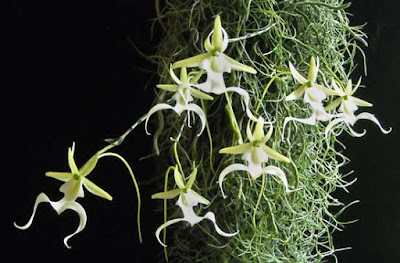Dendrophylax lindenii is native to Florida, Cuba and the Bahamas. In Florida, it is found in the southernmost part of the state including the Florida Keys. It occurs on all of the Bahamas, probably with the exception of the most northerly island of Grand Bahama...
Dendrophylax lindenii also called as Palm Polly, White Frog Orchid, White Butterfly Orchid, The Ghost Orchid, Linden's Dendrophylax, Aeranthes lindenii, Aeranthus lindenii, Angraecum lindenii, Polyradicion lindenii, Polyrrhiza lindenii, is a species of the genus Dendrophylax. This species was described by George Bentham ex Robert Allen Rolfe in 1888.
IDENTIFY DENDROPHYLAX LINDENII
Dendrophylax lindenii is native to Florida, Cuba and the Bahamas. In Florida, it is found in the southernmost part of the state including the Florida Keys. It occurs on all of the Bahamas, probably with the exception of the most northerly island of Grand Bahama. These plants were found in Cuba in several locations. They usually grow in lowland, swampy areas where they grow up to smooth trunks of native royal palms or rough bark of oaks or ash trees.
It is a small sized, hot to cool growing species, leafless epiphytes and their roots have chloroplasts to create the chlorophyll that the plant needs to survive, this function is normally taken care of by the leaves which in this genus are missing.
The Ghost Orchid blooms on a spreading arcuate, 6 to 22cm long inflorescence with scarious bracts and fragrant, 1 to 10 successively opening flowers all arising from the center of the stem that occurs in the early summer in the US and the fall in Cuba. The flowers open consecutively and only occasionally more than one is open at the same time. The flowers have a purely white lip and outer petals, and the inner petals have a delicate cream-yellow or green color. They are effective, fragrant, waxy, durable and are almost 13 cm long from the top of the dorsal petal to the ends of a pair of long, thin ribbon extensions at the tip of the lip.
DENDROPHYLAX LINDENII CARE AND CULTURE
Cultural information should only be used as a guide, and should be to be adapted to suit you. Your physical location; where you grow your plants, how much time you have to devote to their care, and many other factors, will need to be taken into account. Only then can you decide on the cultural methods that best suit you and your plants.
Light:
Dendrophylax lindenii needs a light level of 20000-30000 lux. They need moderately bright, filtered or scattered light with protection from direct sunlight at noon. Strong air movement should be ensured all the time.
Temperature:
It is a thermophilic plant. The average temperature of the day is 32-33 ° C, and the night 21-22 ° C, with a daily amplitude of 11 ° C. In winter the average day temperature is 26 ° C, at night 12-13 ° C, with a daily amplitude of 13-14 ° C.
Humidity:
The Ghost Orchid needs the humidity of 70-75% throughout the year.
Substrate, growing media and repotting:
Dendrophylax lindenii are harder to maintain in good condition, because the removal of fleshy roots from their host trees causes damage often resulting in the death of plants. It is possible that the plants should be kept on the branches of the original hosts, which only minimally harm plants. If the plants were removed from the tree on which they originally grew, it is sometimes possible to reconstruct the plant layout on pieces of bark, tree fern or tree branches by carefully attaching the climbing roots to a moist surface using a wire or thread.
Watering:
In the period from late spring to mid-autumn rainfall is moderate to intense. Then they decrease with the beginning of a dry winter and the dry period lasts until spring. During active growth, the plants should be abundantly watered. At the end of autumn, watering should be reduced, but the plants should not stay dry for a longer period because they can not store water.
Fertilizer:
During the active growth, the plants should be fertilized every week 1/4-1/2 of the recommended dose of fertilizer for orchids. You can use sustainable fertilizers throughout the year, but you can also use fertilizer with an increased nitrogen content from spring to mid-summer, and then in late summer and autumn fertilizer containing an increased amount of phosphorus.
Rest period:
In winter, rainfall is significantly reduced, however, Dendrophylax lindenii take extra portions of moisture in the form of dew even during this slightly drier period. The cultivated plants in the winter have lower requirements for the amount of water, but they should not completely dry out.















COMMENTS